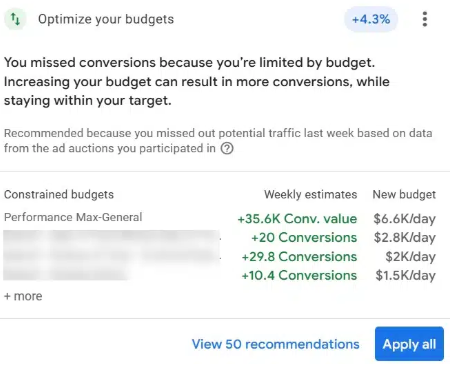The Future of Subscriptions
🔮Going beyond the norm to stop bleeding subscribers, Google Ads Recommendations: What to Ignore, Evaluate, and Use, and more!


Howdy readers 🥰

In this newsletter, you’ll find:
🔮 The Future of Subscription Services: Beyond Box Deliveries
📊 Google Ads Recommendations: What to Ignore, Evaluate, and Use
✔️ Ad of the Day
If you’re new to ScaleUP, then a hearty welcome! You and 50k+ CEOs, CMOS, and marketers have reached the right place. Let’s get into it, shall we? Oh! Before you forget, if someone forwarded this newsletter to you, don't forget to subscribe to our newsletter so you never miss out!

Together with Motion
Creative Trends 2025 just dropped—don’t miss out
Motion just released its Creative Trends 2025 Report—a data-packed guide for every advertiser looking to stay ahead.
Here’s what you’ll find inside:✅ A deep dive into $100M+ in ad spend✅ Survey insights from 500+ DTC advertisers✅ Exclusive takeaways from a dozen top creative experts⭐ 7 game-changing ad trends to watch and test this year
Why does this matter?
Winning brands aren’t guessing—they’re adapting early. This report breaks down exactly what’s working and where the industry is heading.
Motion covers:
- New ad creative formats shaping performance marketing
- Shifts in consumer engagement and preferences
- Proven strategies to scale ad performance in 2025
Marketers, creative strategists, and growth teams—this is your blueprint for smarter ads this year.
Dive into 2025’s Creative Trends now!

🔮 The Future of Subscription Services: Beyond Box Deliveries
Subscription services exploded in the last decade, from meal kits to beauty boxes. But the game is shifting—fast. Consumers no longer want fixed, repetitive deliveries. They demand control, personalization, and real value beyond convenience. The brands that fail to evolve will bleed subscribers.
While the global subscription economy is projected to hit $1.5 trillion by 2025 (Zuora), 40% of consumers have canceled at least one subscription in the past six months (PYMNTS). The takeaway? Retention is now more important than acquisition.
What’s Killing Traditional Subscription Models?
🔴 Subscription Fatigue – Consumers are overwhelmed by too many auto-renewals and are actively cutting costs. If your service isn’t indispensable, expect churn.
🔴 Rigid Structures – The old “monthly box” model doesn’t work anymore. Brands that force fixed commitments instead of flexibility see higher dropout rates.
🔴 Inflation & Discretionary Spending Cuts – As disposable incomes shrink, consumers re-evaluate their spending and prioritize services that feel like an investment, not an expense.
The New Subscription Models That Are Thriving
✔️ Usage-Based Subscriptions – Think Spotify for coffee—where consumers only pay for what they use, not a set monthly amount. Pret A Manger’s ‘Club Pret’ offers subscribers up to five barista-made drinks per day for a fixed monthly fee, making it feel like a daily savings hack instead of a rigid subscription (Pret A Manger).
✔️ Experience-First Subscriptions – Companies like Stitch Fix combine AI-driven styling with personal recommendations, transforming the subscription into an interactive service rather than just a recurring box of clothes. Customers only keep what they like, removing commitment anxiety (Harvard Business Review).
✔️ AI-Driven Personalization – The most advanced subscription brands use behavioral data to auto-customize deliveries. Whoop, for example, doesn’t just sell fitness bands—it continuously learns from user data to adjust health recommendations, community challenges, and recovery plans, making the subscription feel smarter over time (Whoop).
Why Forecasting is the Backbone of Subscription Success
The next evolution of subscriptions depends on precision forecasting—not just to prevent stockouts but to align product availability with real-time consumer demand. Poor forecasting leads to inventory waste, lost revenue, and unnecessary churn.
That’s why leading brands rely on Drivepoint. From tracking ad spend and managing COGS to preventing inventory imbalances, Drivepoint’s advanced forecasting templates help subscription businesses scale profitably, not just aggressively.
The Bottom Line
The future of subscriptions is fluid, on-demand, and data-driven. Brands that evolve beyond the box model and master retention through forecasting, personalization, and community building will dominate the next decade. Those who don’t? Their subscribers will disappear overnight.

📊 Google Ads Recommendations: What to Ignore, Evaluate, and Use
Insights from SEL
Google Ads recommendations can be helpful, harmful, or situational. While some improve campaign efficiency, others push unnecessary spending or disrupt ad performance. Knowing what to apply, review, or ignore can make a significant difference.

The Breakdown:
- Risky Recommendations to Ignore: Budget optimization often prioritizes higher spend over efficiency, leading to inflated costs. Broad match keywords can weaken targeting and increase CPAs if applied without a strategy. Removing redundant keywords disrupts structure and may allow Performance Max to override Search campaigns.
- Recommendations That Require Review: Fixing conflicting negative keywords helps recover lost impressions, but requires careful validation to align with targeting goals. Ad optimization suggestions can improve CTR and conversions, but blindly adding variations can reduce ad consistency. Automated suggestions should be tested before full adoption.
- Effective Recommendations to Apply: Adding sitelinks and callouts boosts engagement and helps ads stand out in search results. Fixing disapproved ads prevents wasted impressions and ensures uninterrupted delivery. Regularly reviewing repair recommendations improves campaign performance by identifying issues early.
Google Ads recommendations can impact budget, reach, and efficiency. Advertisers must evaluate each carefully, applying those that enhance performance while avoiding automated missteps that could increase costs or reduce control.

🎥 Ad of the Day

What Works:
Partnering with Corporate Natalie, a well-known figure in the professional fashion and business space, instantly makes the collection credible.
The four-outfit grid format showcases how the trousers transition from workwear to casual effortlessly. The scattered office papers subtly reinforce the "corporate yet stylish" narrative without over-explaining.
Highlighting "Wear it 4x ways" immediately communicates the product's value—making it an investment piece rather than just another pair of trousers.
What could be Better:
The “12th Tribe x Corporate Natalie Exclusive Collection” feels better suited for a caption rather than being embedded in the visual.
Broader Insights:
Influencer collaborations work best when they align with the product’s core value, and this partnership does that perfectly by reinforcing a polished yet modern professional aesthetic.

Advertise with Us
Wanna put out your message in front of over 50,000 best marketers and decision makers?

We are concerned about everything DTC and its winning strategies. If you liked what you read, why not join the 50k+ marketers from 13k+ DTC brands who have already subscribed? Just follow this.
At ScaleUP, we care about our readers and want to provide the best possible experience. That's why we always look for ways to improve our content and connect with our audience. If you'd like to stay in touch, be sure to follow us EVERYWHERE🥰
Thanks for your support :) We'll be back again with more such content 🥳

